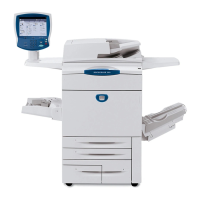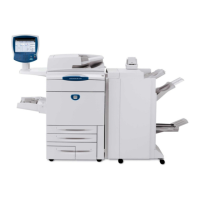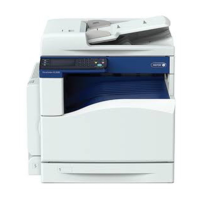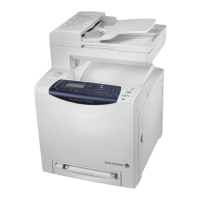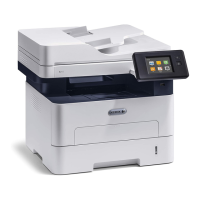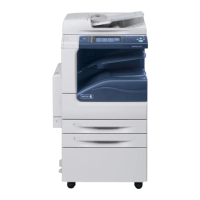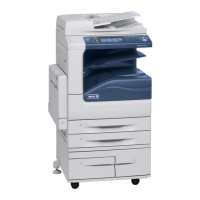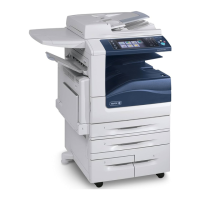1/05
6-4
DocuColor 12/DCCS50
GP 2 Increased Imageable Area Setup, GP 4 Intermit-
Reissue
General Procedures
GP 2 Increased Imageable Area Setup
CAUTION
This procedure is for DC12 Copier/Printers only. Attempting to use this setup on DCCS50
machi
nes may result in Image Quality problems.
The purpose of this procedure is to adjust
the maximum imageable area to allow for full-bleed
printing of 11 x 17 in. images onto 12 x 18 in. paper, or A3 images onto SR-A3 paper. This will
allow oversize sheets to be trimmed to 11 x 17 or A3, with the image extending through the
trimmed area.
Prerequisites
The following hardware/software are required in order to implement this procedure:
• Tag P39 (V5) or higher IOT software level
• DC12 with one of the following DFEs:
–EFI X12 wit
h V1.5 software
– Splash G620 with V2.5 software
– Splash G630 with V3.0 software
Specifications
The guaranteed imageable area is as follows:
• Print mode
12 x 18”
paper - 297mm (+2.0/-0.5mm) x 438 mm (+13.0/- 0.5mm)
SR A3 paper - 297mm (+6.0/-0.5mm) x 438 mm (+6.0/- 0.5mm)
• Copy mode
12 x 18”
or SR A3 paper - 297mm x 432 mm (+/-0.5mm) @105% R/E
Procedure
NOTE: Registration adjustments are not affected by this procedure.
1. Enter the Serv
ice Diagnostics Mode. Refer to Entering the Service Diagnostic Mode
using the PWS.
2. Select Adju
stments in the Service Entry Screen. dC131 NVM Read/Write is the default
screen.
3. Select the ROS tab.
CAUT
ION
Make sure to change both NVM locations. Changing only one location will result in Image
Qual
ity problems.
4. Change the value in locations 720-360 and 720-361 to 1.
GP 4 Intermittent Problem RAP
The purpose of this RAP is to provide guidance for resolving an intermittent problem. This is
not an exact procedure, but a set of recommended actions that use the resources of the ser-
vice manual to help locate the cause of an intermittent problem.
Procedure
1. Check the service log. Recent service actions may provide information about the problem.
For example, a component that was recently replaced to correct another problem may be
the cause of the new intermittent problem.
2. Run the machine in a mode that vigorously exerc
ises t
he function that is suspected. The
machine may fail more frequently or may fail completely under these conditions. Look for
signs of failure or abnormal operation.
An intermittent problem can usually be associated with a RAP, since when it does fail, it
result
s in a F
ail Code, a Jam Code, or some other observable symptom.
3. Using the RAP that is associated with the symptom of the intermittent problem, examine
all of the c
omponents that are referenced in the RAP. Look for:
• contamination, such as a feed roller that has a build up of dirt or toner
• wear, such as gear teeth that are rounded or have excessive backlas
h
• HFSI, even if they are not near or have not exceede
d the SPEC LIFE or COPY
COUNT value
• wires chafing against components of the machine, especially against moving com-
ponents
• misaligned, misadjusted, or incorrectly installed components
• slow or slipping clutches; slow or binding solenoids
• damaged components
• excessive heat, or symptoms of excessive heat, such as the discoloration of a com-
ponent
• loose cables or wires
4. Using the RAP that is associated with the symptom of the intermittent problem, perform
all of t
he adjustments for the components or functions that are referenced in the RAP.
Check to ensure that the adjustment CAN BE MADE and that there is an adequate range
of adjustment, and that it can be set to or near the nominal value. Any abnormality that is
observed may be an indication of the cause of the problem. For example, a component
can be adjusted to the nominal value, but it is at the limit of the adjustment range. This is
not normal and may be an indication of the cause of the problem.
5. Operate all of the components in the appropriate RAP that is associated with the symp-
tom of the intermittent problem with DC330 Component Control (refer to dC330 Com
po-
nent Cont
rol). O
bserve the components for any symptoms of abnormal operation, such as
a hesitation, or an unusual sound.
6. Check that the AC and DC power are within specification.
7. Get technical advice or assistance when it is appropriat
e. This will depend upon the situa-
tion and the established local procedures.
8. Examine the components that are not in the RAP, but are associated with the function that
is faili
ng. Refer to the BSDs. Look for:
• contamination, such as a feed roller that has a build up of dirt or toner
• wear, such as gear teeth that are rounded or have excessive backlas
h
manuals4you.commanuals4you.com
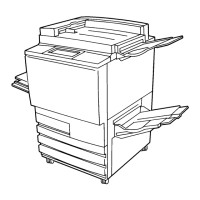
